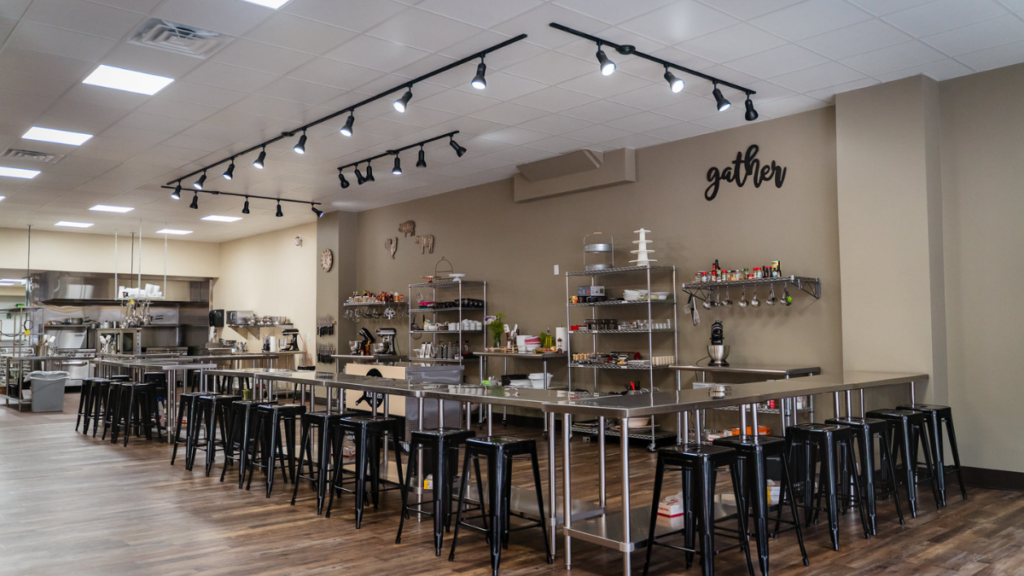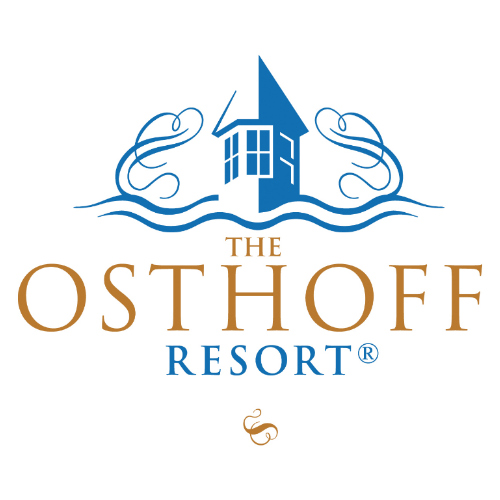The Benefits of Culinary Team-Building Events
07/11/2025
By Kristine Hansen | Photo © CHEF PAM’S KITCHEN
Forget trust falls and awkward icebreakers. If you really want to fire up your team’s connection, try firing up the stove.
Imagine your coworkers not in cubicles or on Zoom calls — but gathered around a sizzling skillet, trading spreadsheets for spatulas. Culinary team-building events are heating up as a flavorful, fun and surprisingly effective way to foster collaboration and boost morale, especially in today’s remote-hybrid world.
Team-building seminars and icebreakers can sometimes flop. But a chef-led culinary competition, with the energy of a reality TV show, is sure to be a hit. This team builder requires as much communication, collaboration and camaraderie as a project, campaign or objective back at the office.
“We take pride in making it seamless for our clients to host memorable events in our kitchen, with the confidence that their guests will enjoy a truly unique and rave-worthy experience. It’s incredibly rewarding to see so many of our corporate clients return with their families and friends, eager to share the magic with their loved ones,” says Bri Dennis, director of events, marketing and communications at Chef Pam’s Kitchen in Waukesha.
The Benefits of Cooking Connections
Chef Pam’s Kitchen began hosting team-building events six months after its 2018 opening after spotting a genuine need with corporate groups.
Generac, Kohl’s, Froedtert and Milwaukee Bucks’ front office are among the firms that have hired Chef Pam’s Kitchen. Drake & Associates, a financial-planning firm with offices in Michigan and Wisconsin, recently hosted 50 female employees for a culinary team-building exercise around Valentine’s Day, handing each of them a long-stemmed rose upon arrival.
Placing everyone in a situation where they aren’t necessarily comfortable or know more than their peers helps equalize the group, breaking down hierarchy barriers that might exist at the office.
“When you do something outside of the office, you get more of their personal side. It breaks down that boundary of showing people your true self,” says Chef Ace Champion, who leads culinary team-building workshops in the Green Bay area. They’re also learning a new or improved life skill: cooking at home.
“Most people don’t cook much,” says Champion. “They’re too busy or don’t know how. When people leave, they’re on cloud nine.”
While chefs who host team-building experiences for groups are happy to customize, they also offer packages that can either take away the decision-making process or serve as a starting point. Another bonus is that these experiences take place in a kitchen on par with what professional chefs use at restaurants and catering companies. “Everybody’s so amazed they’re working in a commercial kitchen,” says Dennis.
Culinary Collaboration
Team work is key. For example, at Champion’s “Chopped Cooking Competition,” each station of four employees cooks part of a two-course menu using an induction burner. If it’s chicken marsala, he says, one team might cook the chicken, another one prepares the sauce and another group cooks a side of green beans.
Judging by Champion is based on how well each person takes orders and works as part of a team, and the client provides a reward, such as a gift card or the chance to leave work early. Then, they enjoy the meal they’ve prepared, served family-style.
“It forces them to mingle with each other,” says Champion.
“Everyone gets interactive. It’s a lot of bantering … not a class where everyone is sitting down at a desk and taking notes. I’m way more entertaining.”
It’s that level of entertainment that also sets these events apart.
Chefs who lead culinary team building aren’t dull or boring: instead, they’re dynamic.
“You get a show and a dinner,” explains John Bogan, the chef and owner of Lake Geneva School of Cooking, which opened a new building in November 2024. The school hosts corporate team-building activities for groups.
Submitting background information about a company in advance — such as a meeting theme or commonly used buzzwords — ensures it’s even more tailored. “We break up into four teams, over four islands, with music playing,” says Bogan. “It’s real cooking, real hands-on, where you help cook the meal.”
He adopts a no-fail approach, with a chef mate at each cooking island to lend support. Each participant dons a chef hat to fully embrace the task. “There’s no intimidation factor. It’s like you’re in my home,” Bogan says. “We don’t act snotty and like we know it all. We want people to go ‘Oh, wow,’ when they eat their food and not mess it up.”
Another reason groups experience success is that they’re using recipes in Bogan’s cookbook, “The Seasons Of My Life” — with photos of the finished dishes.
For Bogan’s 90-minute “Iron Chef Team Building Competition,” each team is assigned a course and also a mystery ingredient they must fold into that recipe. Throughout, there’s a huge focus on using local ingredients, such as River Valley Ranch mushrooms and Wisconsin artisanal cheeses.
“This is a real competition,” says Bogan, who judges the teams — using a scoresheet — based on originality, plate presentation, taste, teamwork, problem solving and creativity. The winning team receives a copy of his cookbook.
Similarly, at Chef Pam’s Kitchen, “they get three secret ingredients each for an appetizer, entrée and dessert,” says Dennis, and have 75 minutes to prepare a three-course meal using dry pantry ingredients along with fresh herbs and vegetables. This meal is then served family-style — along with a salad course and fresh bread — for everyone to enjoy and a plate of each course made for the judges to inspect.
“They’re judged on creativity with the secret ingredients, taste and presentation,” says Dennis. “The team starts with discussing what they’ll make and at the end of the 75 minutes, they’ve become this cohesive unit and they’re proud of what they made.”
This process is more than making a delicious dish. The only way that dish can be executed is through teamwork. “Collaboration, commitments, goal orientation and team leadership, we talk about all of that,” says Bogan. Much of this can also be extended to projects back at the office.
Team building through creating a recipe also breaks down cultural barriers and addresses the lack of face time with some employees being hybrid or fully remote. Bogan has seen this with SC Johnson employees booking an event at his school.
“They bring people in from all over the world — Brazil, Portugal, Spain, France and South America,” he says. “It’s neat because they’re (normally) working on computers and talking on the phone. When they get here, they’re able to really work with each other. They know who this person is now.”
Bogan says that ULINE, Johnson Controls and Milwaukee Tool have also brought employees to his cooking school.
These team-building activities allow personalities to shine — just as they might on work projects. There’s no right way to participate.
“There’s some people who will do whatever you tell them and others take the lead and want to be creative,” says Dennis. “They’re wowed by how fun it is. We’re there to assist them, but I’m amazed at some of the food they put together. Some people, I can sense they are nervous and maybe don’t want to be there, but after 20 minutes they’re all in.”











